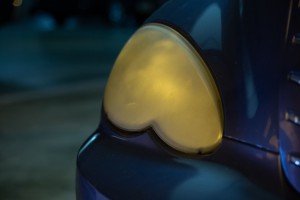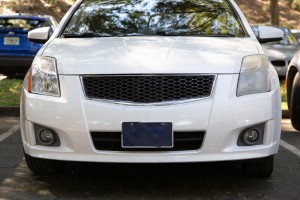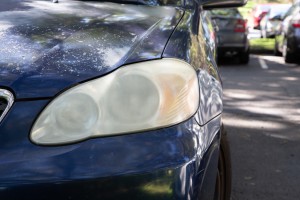We’ve all said it at one time or another: “Are my lights on?” According to a new AAA study, aging and sun-damaged headlights are a major safety issue in the United States.
Yellow or clouded headlights generate about 20% of the amount of light that new headlights do, according to the AAA study. Obviously, this can create some hazardous conditions when driving at night. With half of all accidents occurring at night, AAA encourages drivers to check the condition of their headlights regularly and change them when necessary.
“Walk through any parking lot and it is evident that deteriorated headlights are a problem for most vehicle owners,” said Greg Brannon, AAA’s director of Automotive Engineering and Industry Relations. “Headlights on the road in the U.S., even when new, don’t produce a sufficient amount of lighting, so any reduction in performance is a real safety issue.”
The necessity of headlights to work properly is so important that the Insurance Institute for Highway Safety to develop a new test for brand-new lights and adjust their safety rankings because of them.
(Advanced driving systems can be misleading and may not work anyway. Click Here for the story.)
Good-rated headlights are needed to qualify for a 2018 Top Safety Pick+ award, and good- or acceptable-rated headlights are a requirement for Top Safety Pick. The institute is evaluating headlights on contenders for the 2019 awards, which will be announced in December.

All too often U.S. motorists are traveling darkened roads with headlights light this: damaged and completely incapable of doing the job.
A little more than half of 2018 model vehicles IIHS evaluated are available with headlights that do an adequate job of lighting the road at night and limiting glare for oncoming drivers, but most good-rated headlights are optional or bundled with features that can raise the price of the vehicle.
“Consumers shouldn’t have to buy a fully loaded vehicle to get the headlights they need to safely drive at night,” says David Aylor, manager of active safety testing at IIHS. “All new vehicles should come with good headlights.”
Research revealed that deteriorated headlights, when used on low beam, provided just 22% of the amount of light a new headlight does when operating at full capacity, AAA noted.
(Click Here to see how highway fatalities could again top 40k this year.)
If you have an older car, truck or SUV, you’ll need to take action on your own to get those lights up to acceptable levels. First, you can replace the lights. An important note, if you have an older car, even new, aftermarket replacement lights may not get the job done as well as it could be.
Aftermarket parts also performed well, restoring light output between 83 and 90% of original output, however, these did fail to meet certain requirements for light intensity and were found to be more likely to produce glare for oncoming traffic.
Replacement is better than restoration when it comes to headlights. Though restoration is the most cost-effective option, it offered significantly less improvement in light output than replacement. Professional and DIY restoration returned light output back to approximately 70%. Both restoration methods, however, produced more glare than is acceptable according DOT criteria.
Making the problem worse is the type of headlight used in the U.S. Research shows that halogen headlines fail to safely illuminate unlit roadways at speeds as low as 40 mph, with high beam settings offering only marginal improvements. Even the most advanced headlights tested illuminated just 40 % of the sight distances that the full light of day provides. By not maintaining headlights, drivers are unknowingly operating in dangerously dim conditions.
(To see why IIHS claims advanced driver assistance systems could cause, not prevent collisions, Click Here.)
“Driving at night with headlights that produce only 20% of the light they did when new, which is already subpar, is a risk drivers shouldn’t take,” Brannon said. “Especially when there are convenient and inexpensive solutions that can dramatically improve lighting performance.”



Why isn’t this a justification for a recall? Sounds like a safety issue to me. Maybe it will drive the design back toward to glass sealed beam headlights, styling be damned.
Good report, but on newer cars replacing headlights can be frightfully expensive (and likely contribute to higher insurance costs). By contrast, replacement bulbs for a 1996 Corvette cost as little as $4. What about aftermarket LED or even HID replacement bulbs? Would be great if Consumer Reports started testing and comparing these. Sylvania restoration kits are rated best, according to a couple of published reports.
@Downforce: Replacing bulbs with LED or HID into a housing designed for halogen bulbs does nothing to improve light output or night visibility for the driver. It just creates glaring light that is rough for oncoming drivers and can actually cause “tunnel vision” for the driver of the equipped-vehicle. Not only that, it is illegal to change the bulb technology per the NHTSA — it is illegal to install a HID or LED bulb into a halogen housing– changing the lighting source (bulb) to a different technology than the housing was initially designed for, is illegal.